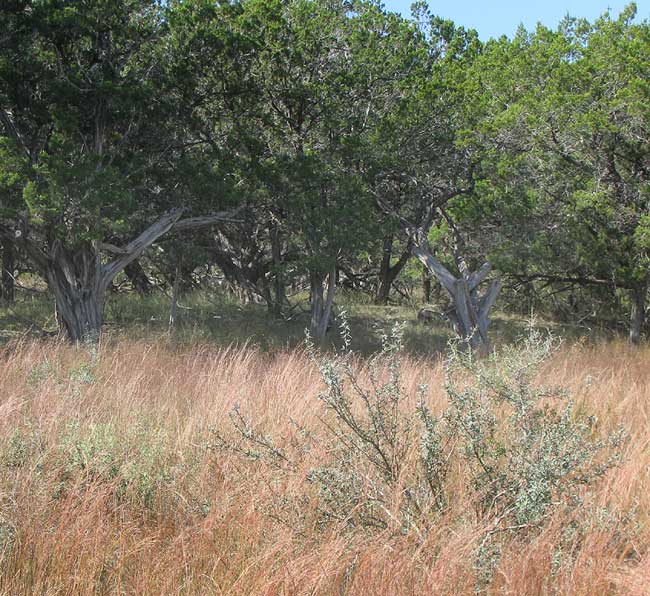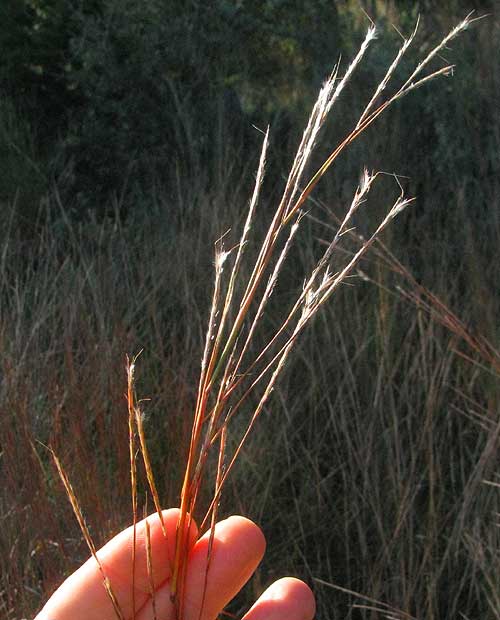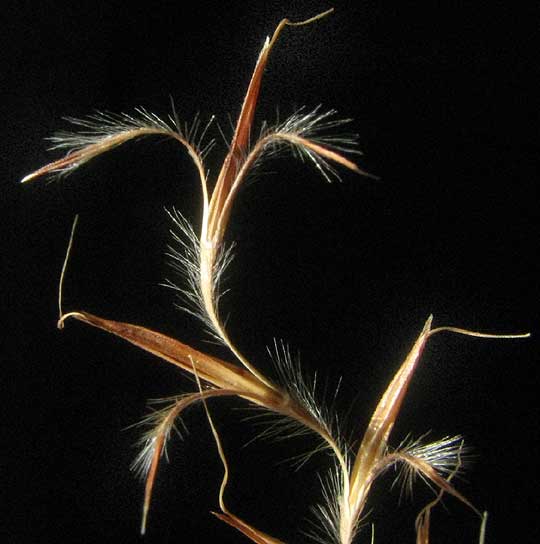Excerpts from Jim Conrad's
Naturalist Newsletter

from the November 11, 2012 Newsletter issued from the valley of the Dry Frio River in northern Uvalde County, southwestern Texas, on the southern border of the Edwards Plateau; elevation ~1750m (~5750 ft); N29.62°, W99.86°; USA
LITTLE BLUESTEM
In the last Newsletter we saw how Big Bluestem Grass forms extensive carpets of single-species grassland in pastures occupying the flat floodplain of the Dry Frio River Valley, as well as the "lawn" around the cabin in which I live. You may want to compare Little Bluestem with what's on our Big Bluestem profile page..
At the very base of the limestone hills framing the valley, exactly where the flat floodplain and its big pastures meet the hills' lowest slope, and short, fairly open forests of Ashe Juniper and Texas Live Oak begin, Big Bluestem disappears and another taller, yard-high (1m) grass takes its place. Nowadays this taller grass is flowering as its long, breeze-bent leaves take on a slight blush of rusty coloring, shown above.
This grass's flowering heads are fairly open and not so bushy, as shown below:

This grass is Little Bluestem, SCHIZACHYRIUM SCOPARIUM, one of the "Big Four" grass species mentioned last week as constituting the main grass species of the vast grasslands or prairies that once occupied much of central North America. If only because of its abundance, historically it has been of enormous ecological value, being a prime food source for grazing animals such as Bison and deer. It has protected vast stretches of land from erosion, its tough, slender, narrow leaves still serve as excellent nesting material for many species of birds and rodents, and its seeds are a major food source for many small birds. Its abundance places it at the foundation of the mid-continent natural grassland ecological pyramid. Little Bluestem is simply one of the most important flowering plants on Earth.
By the way, it's interesting that -- at least in our valley -- Little Bluestem averages about twice the height of the Big Bluestem we looked at last week. In many other areas it's the other way around.
In the above picture you saw that the heads are somewhat narrow, like gnawed-on toothpicks with very frayed tips. That's what the fruiting heads look like most of the time, but if you visit the grass in late afternoon on a hot, dry day, you'll see that the heads have opened up, exposing the ultimate inflorescence branches to the wind. The grass's parachuted, achene-type fruits are wind disseminated. The sun-dried, curvy inflorescence branches are distinctive, and elegant, as shown below:

These fruiting heads are so unlike those of more commonly encountered species that a little effort may be required to understand what we're seeing. A close-up of one of the above ultimate inflorescence branches is shown below:

Remember that we explain basic grass-flower anatomy terms at http://www.backyardnature.net/fl_grass.htm.
That picture shows the tip of an ultimate inflorescence branch consisting of three connected "paired spikelets." The paired spikelets are technically referred to as rames. At maturity the inflorescence branch breaks up, or disarticulates, so that each rame is carried off by the wind separately. Notice that the top rame looks a little like a slender bird with its narrow wings open, or maybe it's like a fleur de lis symbol. The top rame's bottom is connected to one of the "wings" of the second-from-top rame, and that rame's base unites with one of the "wings" of the third-from-top rame. On and on it goes all the way down the whole inflorescence branch.
When the top rame is carried off by the wind, the second-from-top rame will look like the top rame now looks, like a flying bird. However, now we know that one of its wings actually is the fuzzy base of what was once the topmost rame. Thus one "wing" of the rame is actually the inflorescence stem, or rachis. So, what's the other "wing?"
The other "wing" is the rame's second spikelet. Each rame consists of a large spikelet without a flower stem, or pedicel, and a second smaller spikelet on a slender pedicel. The large spikelet produces an achene-type fruit, but the smaller spikelet on its pedicel is sterile. Seeing the hairs on this second, sterile spikelet, we can surmise that its main function is to serve as a "wing," to help in wind dissemination.